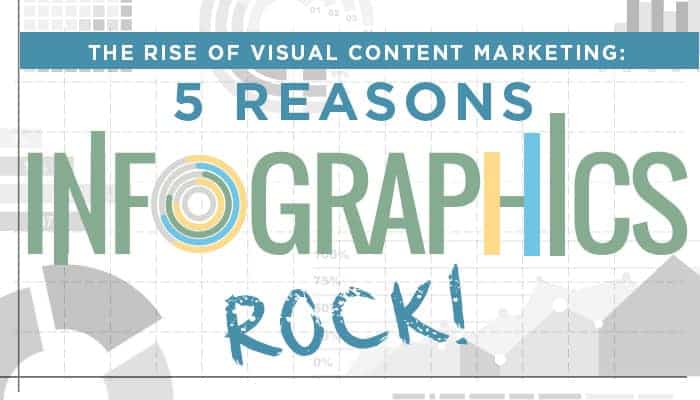“There is a magic in graphs. The profile of a curve reveals in a flash a whole situation — the life history of an epidemic, a panic, or an era of prosperity. The curve informs the mind, awakens the imagination, convinces.”
―Henry D. Hubbard
Can we really say it any better that that?! Graphics have come a loooong way since the early 90s aesthetic of blocky text and primary colors, and infographics are no exception. If you want to give your business an edge, it’s time to give visual content marketing a shot and jump on the Infographic train. Choo choo!
1. Science backs up why people love infographics.
Visual content is easier on the brain. Way, way easier. In fact, it’s 60,000 times faster to process an image than plain text. Humans like things to be easy—some might call that lazy, while others say that it’s ingenious. However you describe it, it’s an incontrovertible truth that people prefer receiving information in ways that are simple to understand.
90 percent of info transmitted to brain is visual, so our brains are extremely efficient at comprehending visual cues. When things are easy to digest, they’re easy to share. Infographics drive way more traffic and engagement than almost any other content—and traffic and engagement lead to conversions, which is why you’re here, right?
2. Visual content marketing is insightful—the numbers don’t lie!
Infographics are an astounding 30 times more likely to be read through than text. This means you basically have a guaranteed way of not only capturing your audience’s attention, but keeping it until they’ve learned what you want them to about your brand. As Bob Shneiderman once said, “The purpose of visualization is insight, not pictures.”
Your audience might think they’re just looking at a pretty image, but infographics are actually a sneaky way of hitting them with a proper narrative that says exactly what you want it to about your brand.
There were 62 million collective results for the search “infographic” as of April 2015. The numbers just don’t lie. People go bananas for graphics, and when you tie in relevant information, everybody wins.
3. Infographics are easy to personalize.
Custom content is a good way to flex your muscles as a CMO. It’s a killer way to prove that your brand is a proper influencer, a thought leader, a relevant voice in the discussion. It also shows that you have the resources to make and not just take.
When you write a blog post, you always run the risk of someone simply copy/pasting/reposting your efforts as their own. Not so with infographics. If you include your brand’s logo on the infographic itself, it can’t be separated from your brand without a proper Photoshop edit—so every share will lead potential clients right back to you.
Creating custom infographics is also a really savvy way to market to different audiences and buyer personas. Businesses that produce content in multiple forms have higher chances of hooking clients and then reeling them in with a sale.
4. Creating an infographic is simple.
There so many tools you can use to create your infographics if you don’t have a graphic design team. Piktochart is free for casual users and $29/month for premium, which removes watermarks, adds privacy controls, and creates higher resolution graphics for offline use. Its customizable templates let you tweak fonts, upload vectors, or use premade images. Users can also embed videos into their infographics on this intuitive site.
Infogr.am is for the chart-lover among you. You can create over 30 kinds of charts, from bubble to tree to pie using its built-in spreadsheet function. There’s no image library, so it’s a less comprehensive tool.
Google Fonts provides a great library of typefaces for use in all kinds of web development and graphic design projects. All of the fonts are open source, so you can use them however you want and customize them, too.
5. Infographics go viral.
Infographics go viral faster and better than plain text, that’s for sure. You can improve your chances of your infographic making the rounds online by following Neil Patel’s advice and doing a few things:
Make it embeddable by placing social sharing buttons on the page that hosts it. (Remember: humans like easy!)
Post it on social media yourself. First, pin it on Pinterest. Graphics do really well there, and it’s likely that your pin will reach the right audiences through the correct pinboards. Also pull facts from the infographic and use them as tweets with a link to the full graphic. Release one every few hours, then rinse and repeat a few days later. Do the same on Facebook and Google+ but with more time between posts.
Submit your infographic to directories like Visual.ly, Daily Infographics, Infographic Journal, Infographics Archive, and I Love Charts.
Manually reach out to any influencers who might share your infographic, like popular bloggers on similar subject matter. This is a numbers game, so don’t be shy about contacting a bunch of people!
At Zen Media, we have a dedicated design team to create striking, useful graphics for our clients. They wanted me to pass on the following tips for designing an infographic:
- Use a complementary, limited color palette. Too many colors can be overwhelming and distract from your overall message.
- Similar type styles will improve readability and look professional and sophisticated. Avoid Comic Sans unless you’re the CMO for an agency of birthday clowns.
- Follow narrative flow! An infographic doesn’t just list facts; it tells a story. Take your readers on a journey by providing information they can’t receive anywhere else. That will earn you conversions and brand loyalty. In the same vein, avoid clutter. Too much information is just as bad as not enough and will overwhelm.
- Negative space is to an infographic what the yin is to the yang. It’s very Zen and draws the eye to the most important pieces of information.
- Cite your sources at the bottom! Nobody likes a thief, and showing you’ve done your homework is helpful in creating credibility.
If you don’t have the time or skill to create your own infographic and then aggressively market it, contact Zen Media today! We’d be happy to integrate infographics into your overall content marketing strategy.





